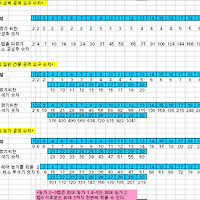각유닛 스탯 에는
공격력
일반 방어
대 기마방어
궁수방어
의 4개 전투스탯이 있고
공격력의 경우, 일반공격력 적용을 받는 유닛은 창병 검투병 도끼병 공성추 투석기 귀족 입니다.(이후에는 보병공격력이라 하겠습니다)
궁수와 기마궁수는 궁수공격력 적용을 받고,
영웅, 기마병, 무장기마병은 기마공격력으로 처리됩니다.
방어시에는, 공격하는 병사의 적용공격유형과 동일한 유형의 방어력만 적용됩니다.
유닛간에 우선타격 순위, 우선몸빵순위, 레피드 파이어 개념은 없습니다.
한순간에 한 파트가 공격하는것이 아니라 꽝! 박치기하는겁니다.
공격자의 공격력과 수비자의 수비력이 충돌합니다.
한방에 꽝! 입니다.
뭐, 여기까지는 거의 모든 분들이 다 아시는 내용일 것 같습니다.
다음 내용입니다.
보병공격력 총합 + 기마공격력 총합 + 궁수공격력 총합 = 공격자 공격력이라 할때.
총 공격력 대비 각 세 파트별 공격력이 갖는만큼의 비율에 따라,
해당 비율만큼의 방어 유닛과 전투하게 됩니다.
every fight is split up into group fights... (infantry / cavalery / bow)
nobleman, rams and cata's are infantry if i'm correct.
Offensive army's will be calculated accordingly also in their 3 groups.
The attacking army will then be calculated by total offense by 'group'
this will then fight the defending army
if you send 60% infantry in your attack this will fight against 60% off the defense. The defense will be split into equal groups (if you have 3000 spear sword and bow it will be divided 1000 of each.)
example with numbers:
Attacker sends 7000 axe, 2000 lcav, 1000 ridden bows
defender has 6000 spear, 6000 sword and 6000 bow, lvl 20 wall, luck = 0
the offensive force of axe = 7000 x 40 = 280.000
the offensive force of lcav = 2000 x 130 = 260.000
the offensive force of ridden bow = 1000 x 120 = 120.000
total force = 660.000
axe = 42%
lcav = 39%
bow = 19%
defending troops will be divided
42% of spear, bow and sword vs axe = 2250 of each vs 7000 axe
39% of spear, bow and sword vs lcav = 2340 of each vs 2000 lcav
19% of spear, bow and sword vs vs bow = 1140 of each vs 1000 bow
and then the fight is on
to make that understandable i will give an easy example:
Offensive strength of the infantry: 20’000
offensive strength of the cavalry: 50’000
offensive strength of the archery: 30’000
then 20% of the defensive troops fight against the infantry, 50% against the cavalry and 30% against the archery. These three fights take place at the same time
after these first round there are two possibilities. Either there are no surviving troops on the defenders or offenders side or there are surviving troops on both sides. In the first case the fight is over, in the second case an additional round is fought.
The second case may occur, if for example the infantry and archery wins their fights and the cavalry loses its fight.
Now it starts all over and all the things are calculated as in the first round, of course only with the remaining troops on both sides. These rounds are repeated until one side lost all troops.
뭐, 내용을 간단하게 요약해보면 7000명의 도끼병 2000명의 기마병 1000명의 기마궁수가 마을을 공겼했다고 했을때,
각각의 그룹별 공격력은
보병 그룹 : 7000 × 40 = 280,000
기병 그룹 : 2000 × 130 = 260,000
궁병 그룹 : 1000 × 120 = 120,000 이고, 총공격력의 합은 660,000이 됩니다.
보병, 기병, 궁병 그룹의 각개 공격력은 총공격력의 42%, 39%, 19%를 차지합니다.
방어측 병력역시 세 그룹으로 나뉘는데, 공격측처럼 병종에 따라서 나뉘는게 아니라
전체의 42%, 39%, 19%, 이렇게 나뉘게 됩니다.
방병의 42%는 적의 보병과, 39%는 적의 기병과 19%는 적의 궁병과 싸우게 되는 것이지요.
그후에는 세개의 전투가 동시다발적으로, 공격력과 방어력의 충돌로써, 이루어지게 됩니다.(이 한번에 이루어지는 세그룹의 전투를 라운드라고 부릅니다.)
공격자측과 방어자측중 어느 한측에서만 세 그룹의 전투를 모두 이겼을때, 즉 한라운드를 모두 승리로 이끌었을때, 전투는 종료되고, 승패가 갈리게됩니다.
만약 첫번째 라운드에서 공격자가 보병, 기병 그룹에서의 전투는 이기고 궁병 그룹에서의 전투는 졌다면, 남은 잔존병력의 공격력 총합과, 각각의 병종별 그룹생성을 해서 첫번째 라운드처럼 다시 두번째 라운드에 돌입합니다.
전투는 최대 3라운드까지 연장될수있으며, 한라운드 안에서 한 그룹의 전투에서 이겼다는 의미는 그 그룹과 대치한 병력을 몰살했다는것을 의미합니다.
이상입니다, 지금까지 이렇게 전투에 대한 구체적인 정보까지는 몰랐었는데, 오늘 처음 알게되었습니다.
다른 분들께도 이 정보가 도움이 된다면 좋겠습니다.
'Computer > 부족전쟁' 카테고리의 다른 글
| 부족전쟁 정찰병 운용,, (0) | 2012.07.12 |
|---|---|
| 부족전쟁 투석기&공성추 최소요구량 (0) | 2012.07.12 |
| 부족전쟁 용어정리 (0) | 2012.07.12 |
| 부족전쟁 포럼 프로필 아바타, 서명 넣기 (0) | 2012.07.12 |
| 110101 5세계 전쟁 포기선언문 (0) | 2012.07.12 |

